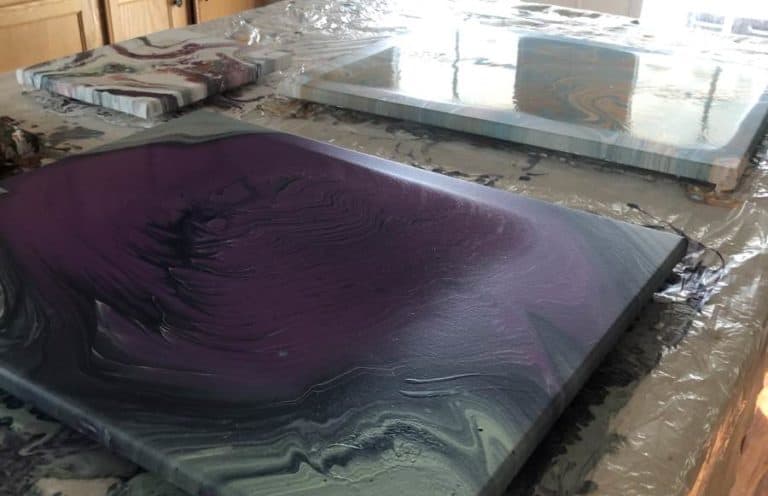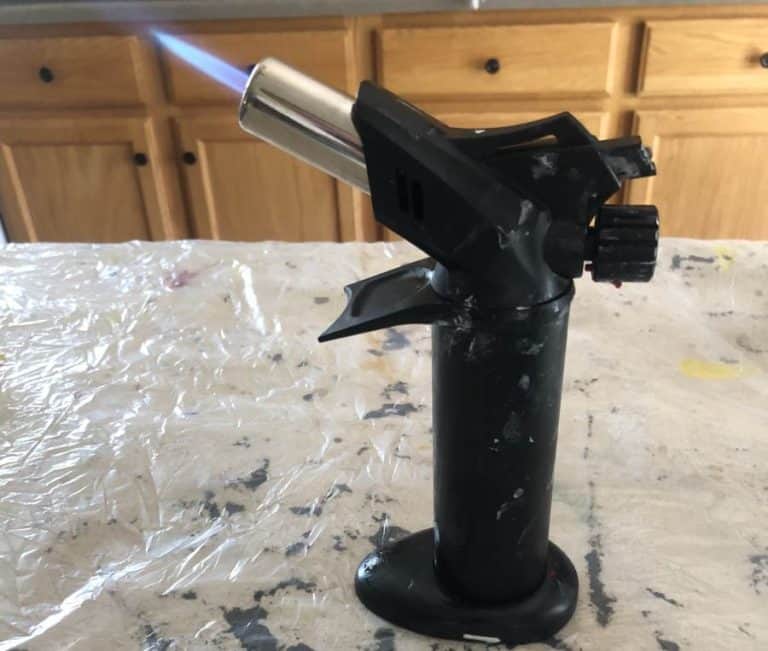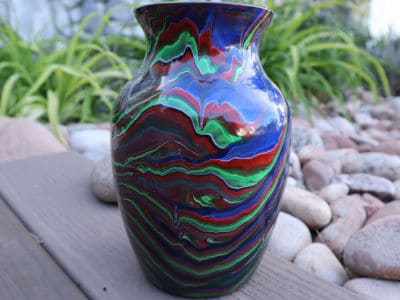How to Store Acrylic Paint?

If you’ve gone head over heels for acrylic painting, specifically acrylic pour painting in my case, you most likely have a problem with paint containers being everywhere. I probably have a hundred small bottles and tubes of paint that I have accumulated over this past year. I’ve done a little research to figure out how to store them to help lengthen their shelf life.
How to store acrylic paint? Acrylic paint should be stored in an airtight container, away from wet or damp locations, and in a place where the temperature will remain around 65° – 75° F.
While these are the basics of storing acrylic paint, here are a few more things you should consider before putting your paints away.
Note: Acrylic paints on a palette or otherwise removed from a proper container have special storage needs not covered in this article.
Shelf Life of Acrylic Paint
Every manufacturer of acrylic paint gives a different shelf life estimate for their products. Each of these estimates depend on a number of different factors which will be discussed later in this blog. Unfortunately, only a few of the acrylic paint manufacturers actually print expiration dates on their product or mention them on their website.
Of the major manufacturers, I only found one reference to the shelf life of acrylic paint. On their website, Liquitex says:
“you can expect a 5-7 year shelf life from Liquitex acrylic products, provided the materials are stored properly at room temperature, kept tightly capped and kept free of contaminants.“
Liquitex
There is some anecdotal evidence, based on my research into acrylic shelf life, that some acrylic paints have been known to last well past a decade. Many artists claim they have successful used paints, either from their own collection or paint that has been donated to them, that have been sitting for 10, 15, and even 30 years.
Storage Location Considerations
When making the decision on where to store your paints there are a few things for you to consider. You’ll want to select a place that has a relatively constant average temperature and somewhere where there isn’t a lot of moisture accumulation.
Why Temperature Matters
Acrylic paints are water-based paints that dry much more quickly than oil-based paint. Being water based, these paints are especially sensitive to extreme temperatures. Too much cold and the water and other components of the paints will freeze. With excessive heat the paint will dry out and become unusable.
It is recommended that you keep your paints in a location that remains between 65° and 75° all year round. When the temperatures vary 10° or more outside of this range there is a chance that the natural separation of the emulsion (mixing of two materials that in normal circumstances don’t mix) of which the acrylic based paints are made.
Moisture and Paint Storage Don’t Mix
When actually painting with acrylic paints, you would generally want some moisture in the air to help keep the paints from drying out quickly. In the case of paint storage, however, moisture can be your worst enemy.
As was mentioned previously, paints need to be kept at a constant average temperate. Unfortunately, that recommended temperature range is also an optimal temperature range for many things to grow, including mold and mildew.
To prevent mold and mildew from growing on paints in storage, you need to reduce that amount of moisture in the air around the paints. Here is a quick checklist of places where you should NOT store paint.
- Near running water like in a bathroom or kitchen.
- In an area where clothes are washed or dried.
- Next to exposed wood or concrete as these both can retain moisture.
- In a utility closet with furnace or air conditioner where there is excess airflow and water in the air.
- Near a door to the outside where contaminates are abundant.
Special Considerations for Pour Paint Mixes
When doing acrylic paint pouring, you are more than likely adding a pouring medium to your paint. This medium can include anything from water to glue to professional pouring mediums.
Because this acrylic pour mixture is made up of even different types of materials, the shelf life of paint with pouring mediums included becomes a bit more complicated.
Anytime mixing is happening, additional contaminates from the air, from the different additive bottles, from the items the paint is stirred in, and the container used for mixing itself are introduced into the newly created compound.
This variability makes the shelf life of pouring paint mixtures to be drastically reduced. Many artists recommendations I found advocated that you only keep a paint pouring mixture for a few weeks at most before throwing it out. I have personally had a few of my pouring mediums concoctions go bad in a matter of 10-12 days.
How Long Will the Paint be Stored?
Another major consideration to keep in mind is the length of time you expect the paint to be stored. If you are a frequent painter, you might only have paint on hand for a few days or weeks before you will have used it all up. If you are like me, all of your paint gets stored together and some of it gets used quickly, and others get used less frequently.
When paint is used up quickly, it is less likely that variability of temperatures or moisture levels will affect the lifespan of the paint. The longer the duration of storage, the more important these considerations become.
You should always keep in mind the amount of time you plan on storing your paints and plan your repository accordingly.
Containers for Paint Storage
Every artist has their personal methods for their paint organization and storage. Some like them throw together and others like them all laid out and color coded. Whichever your personal affectations are, here are a few choices you have on different containers to store your paint.
Original Container from the Manufacturer
Acrylic paint come prepackaged in some pretty durable containers. Craft paints commonly come in plastic bottles in a range of sizes. Student quality paints generally ship in plastic tubes. Artist or professional quality acrylic paints usually come in more robust canisters or metal tubes.
With any of these containers, the most important thing to look for when storing paints are that the lid closes and seals, and that the container doesn’t have any holes or cracks. Since acrylic paints are made of water and other volatiles, exposure to the air is a two-fold problem. Paint can dry out and it can breed mold and mildew. Both of these problems are reduced drastically when paint is sealed in an air tight container.
Short term storage of paints in their manufacturer packaging will most likely be the default way paints are store. There are a plethora of different options for arranging your paint for short term storage and I recommend you review our resources pages for ideas.
Common Household Items for Paint Storage
If the original containers are not usable or compromised for any reason here are a few common household items that you could use to store your acrylic paints in. In every case, the container must be washed thoroughly, and the lid must either screw on or seal completely or the paint will not last as long as you might expect.
- Mason Jars with new lid (long)
- Condiment squeeze bottles (short)
- Tupperware (short)
- Used pop/water bottles (average)
- Used butter/soup/sour cream containers (short)
- Coffee tin (short)
- Any bowl/container with saran wrap or press n’ seal (very short)
Long Term Storage
Long term storage of acrylics, while not hugely different than short term storage, does require a bit more foresight. Here are a few tips and tricks to use for long term storage or for short term storage in locations where humidity is very high.
Tips & Tricks
- Add mold & mildew inhibitor directly to the paint
- Put the paint containers in a larger air tight container
- Put a disposable diaper in the location where paints are stored
- Add silicone moisture absorbing packets where the paints are stored
- Use plumbers’ tape on screw on lids to tighten the seal
Acrylic paint can definitely go bad. For additional information on some of the most common issues that cause acrylic paints to go bad see our blog post here.
PRO TIP: Write the date you purchase your paint on the original paint container in a black permanent marker. I usually do this on the lid.
Related Questions
Can I add glycerin to acrylic paint? Most acrylic paints probably have a small amount of glycerin already in them which acts as a conditioner and drying retarder. Adding more may affect the properties of the paint. Small quantities in relation to the paint quantity will retard (slow down) drying times.
How do I preserve acrylic paint? Preservation of acrylics rely on the same basic tenants of acrylic storage mentioned in this article. Make sure the paint stays at a consistent average temperature (65° – 75° F) and limit the exposure to excessive moisture.







Hi, I’ve heard that it’s better to store your paints upside down so they don’t dry as quickly. Any views on that
For higher quality paints you probably do want to store them cap down. That lets the paint create another seal so no additional air gets in. For lower quality paints like craft paint, I have had too many leak on my to trust them upside down. Now I just make the cheap or craft paints with a date and don’t use them if they are too old.
For decades I have used that acrylic paint that comes in 2fl oz plastic bottles. I used them either “lots or not at all” according my project.. I have accumulated “too many” little bottles over decades. Yesterday I started a new project: combining same color , same brand paint into larger glass (washed by hand and then dish washer) jars. The theory being a small puddle dries up faster than a lake’s worth of water. I labeled the jars, cleaned the rims and dried them and then put a piece of plastic wrap over each rim and screwed down the jar lid tightly. We will see what happens to the paint. I would like to put them in the garage but after reading this article I will put them back on the shelves in an extra bedroom.
Sounds like a fun project. Just make sure you check each individual bottle for spoilage or drying. You might strain them with a mesh kitchen strainer as you put them into the new glass container too. Good on you for trying to save them rather than just throwing them out.
I live in Southern California where heat waves are prevalent. What can I do to try to keep my paints usable for a longer period? I use Nova paints. I have them in a wood cabinet in our entertainment center in my family room.
As an acrylic paint pouring artist we don’t generally have this problem because our paints are mixed with a pouring medium and sometimes some water. It would take days for prepared acrylic pouring to dry significantly. However, my good friend Chris at drawandpaintforfun dot com (I don’t allow URls in my comments so you’ll have to fix it) has a great article about this. The article title is prevent-acrylics-from-drying-on-palette.
Hi David, have read gently taken to acrylic painting and pouring. Thank you so much for the tips you’ve given. They’re going to help me a lot .
Thanks again,
Sharon
You are very welcome. If you have any additional questions please let me know.
David, THANK YOU for your selfless dedication to helping others prepare for the craft of acrylic pouring. On and off–I have dabbled in acrylic painting for years. I recently discovered acrylic pouring and I believe I’m getting hooked by simply watching your YouTube videos! I haven’t attempted my first pour–as I’m a bit like you where I like to research and take notes and ensure I’m READY. I’m 63 and looking forward to my retirement in a few years and can see myself enjoying this craft indefinitely.
Gary
I am sure you’ll be addicted even more after doing the first pour. It’s an amazing feeling to create art and to let a good portion to chance.
I’m feeling confused. I have seen a few artists’ videos where they are using their premixed paint/pouring medium which they are keeping in something like plastic squeeze bottles…and I thought they were saying they premixed and stored routinely. But in searching for confirmation of this I have had a hard time finding any information. If I’ve read your article correctly, you are saying that storage of your premixed paint/PM is probably only sensible for a couple of weeks at most? If so, I can see a prolific artist using that method, but not sure if it would be sensible for me. Just wondering! Thanks so much for your articles, I’m getting a lot out of them.
The problem is water. As soon as you add water to a pouring medium you lose your time as it will eventually start to mold and mildew. If you mix without water it will last months.
For you, mix your medium how you like it and then only add water when you are finally mixing it with the paint. That way you have a longer shelf life and you don’t have to worry about spoilage.
Thank you for such a clear (and fast!) response. Now I’ll take the question one step further …. can I mix Floetrol and paint, and then store it for any length of time, only adding water when I’m ready to pour?
Hi, I am just starting this hobby and had the same questions about acrylic paint and Floetrol ( no water) mixture storage. Everyone seems so vague on the subject. I just want to know once and for all how long can I store my premix in sealed bottles. Did you find out? Thank you.
Sealed containers, it will start to separate within a month. That is no problem as you can shake it and get it to mix correctly again. After around 6 months (based on acrylic paint) the settled materials starts to dry and you may get lumps when mixed again.
Thanks man You help me so much
A pleasure Jeff. Thanks for the note and reading the blog.
👋 Hi there,
Any tips to get that last bit of acrylic paint out of old bottles? I’m wondering if a tsp of warm water? Or heating the bottle for 5 seconds would work?
Thanks
I’ve used rock salt or small beads and shaken it around. A baby’s bottle brush works wonders to stick in and wash things out if you can find a wand brush small enough. The problem is that water by itself won’t pull dried paint off the side. You either have to have an abrasive or a really good negative charge (if the bottle is silicone) to pull the paint off. I haven’t tried microwaving but you could try it.
Hi, I am just starting this hobby and had the same questions about acrylic paint and Floetrol ( no water) mixture storage. Everyone seems so vague on the subject. I just want to know once and for all how long can I store my premix in sealed bottles. Did you find out? Thank you.
I store my acrylic paints in small screw-top jars (used to contain pimientos usually.) I have had the problem of mold growing in the jars for years and years. Usually I spray the inside with Lysol, directly on top of the paint, but the mold comes back again and again. There must be some kind of product I can buy to put in the jar along with the paint to prevent mold. Do you have any knowledge of such a product? Can’t seem to get clear answers online.
Thanks
I honestly would not store your paints in an enclosed air tight container. It seems that they aren’t seals and some of the moisture is leaking out creation a biome for the mold to flourish.
I store all my paints in paints just in the open air. I am in Utah where it is relatively dry though but I have my AC on in the summer which puts some moisture in the air.
I am using TLP pigments a lot these days mixed with Behr 8300 and polyurethane varnish to make my own paints. Where do you think these belong in your specific gravity chart?
Thank you so much for all your help,
I honestly don’t know. I’d have to do some testing but I haven’t used that brand specifically.
David, This is a stroke lady, It
” Click” one day.. My dad Is a “GE-Sabic ” For 45 yr. In is in the lab And a chemist .. He know Exactly What you mean By pouring Elmer’s School Racio. I’m thinking about house paint And glue.. What do you think?
I have never used house paint with a medium. I’ve only used it by itself in the Sheleeart Blooms technique. I’d start with 1 to 1 and then add water for consistency.